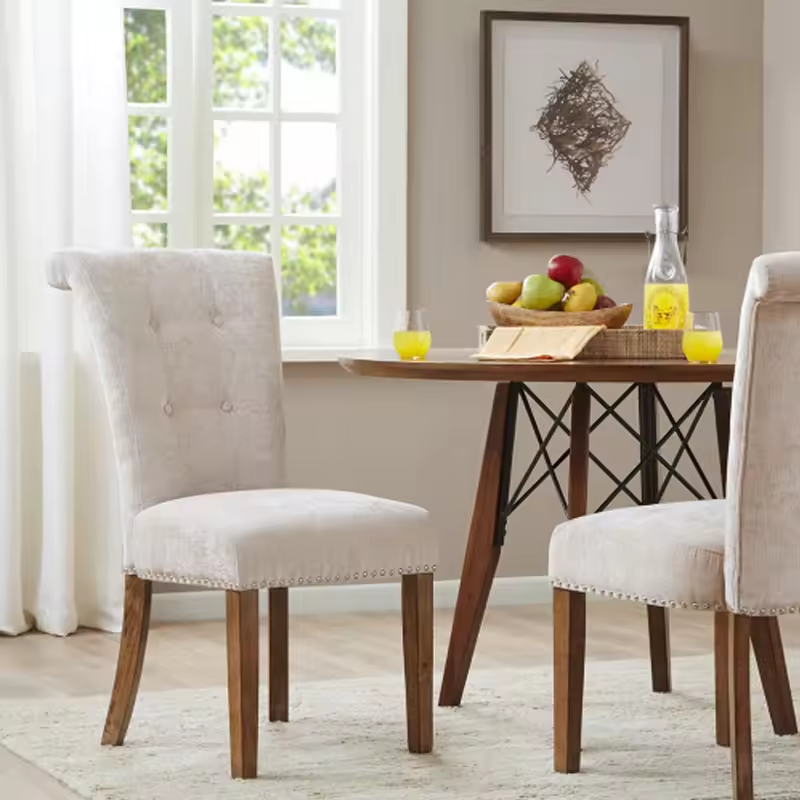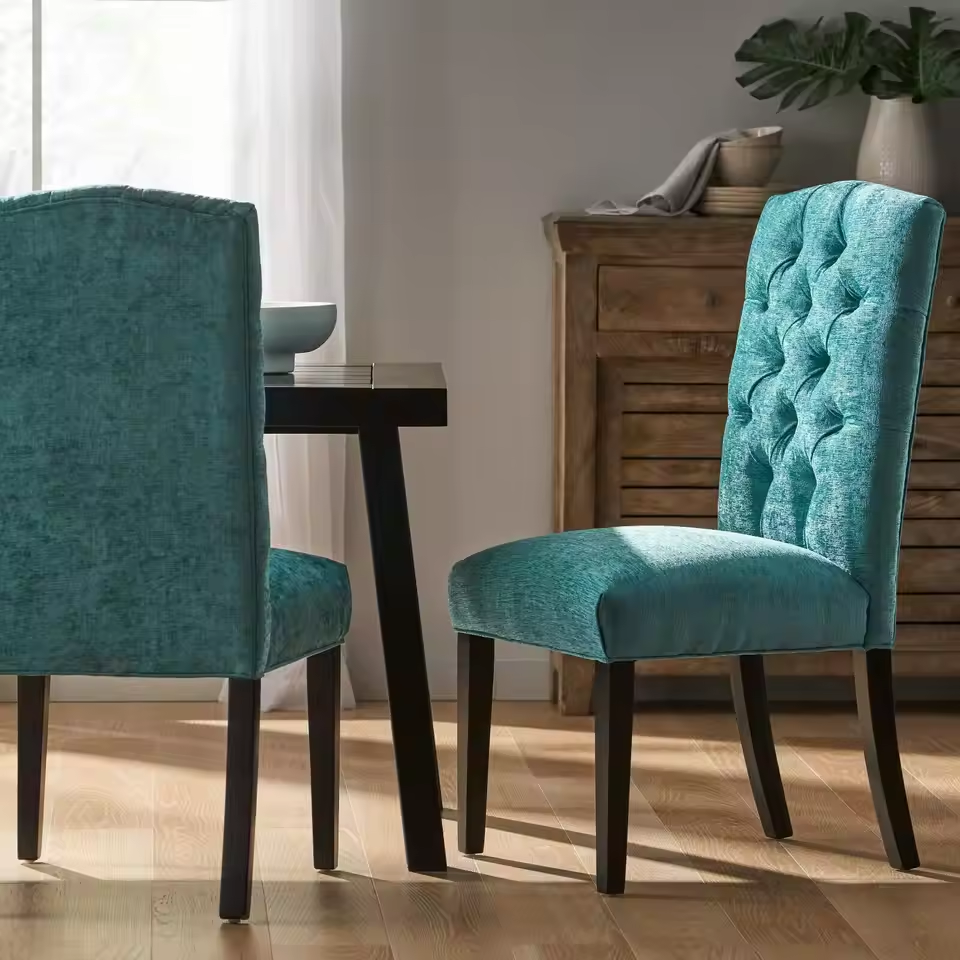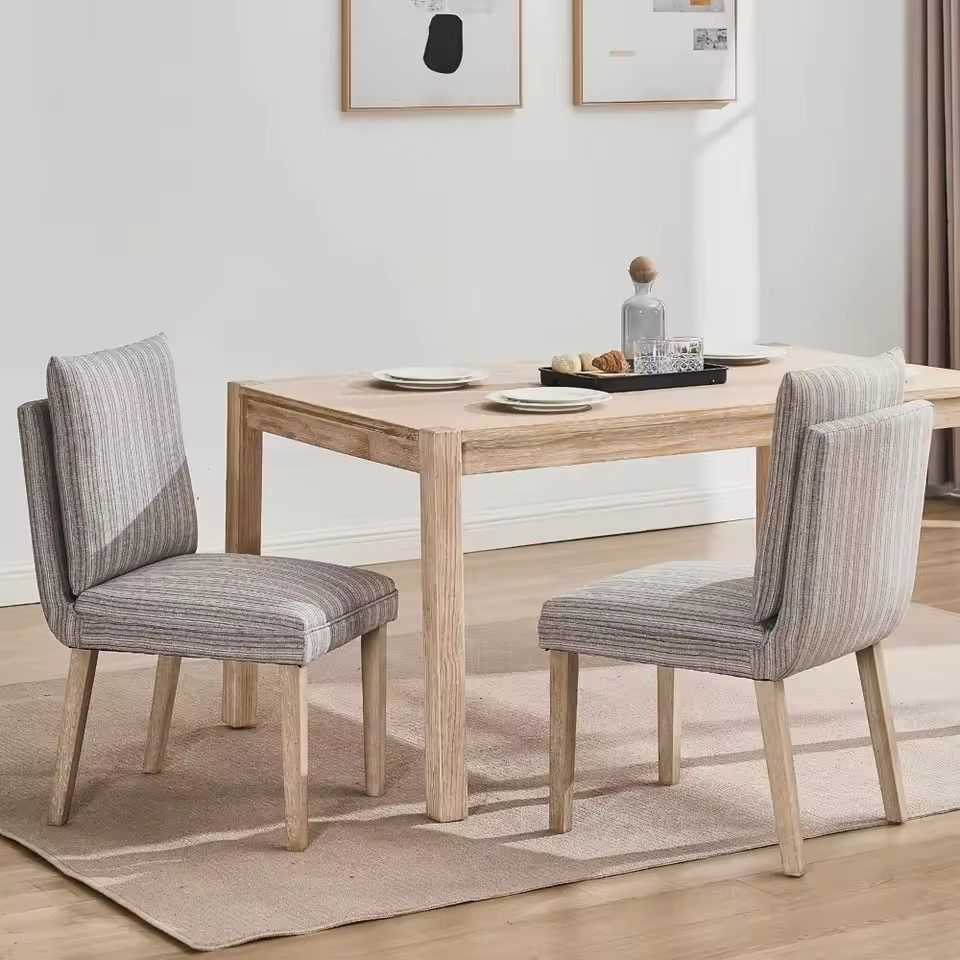The Importance of Dining Chairs in Your Home Design
Dining chairs are more than just functional furniture; they are a cornerstone of your home’s aesthetic and daily functionality. Whether you’re hosting intimate dinners or casual family meals, the right dining chairs set the tone for your dining space. They must balance style with comfort, ensuring both elegance and practicality. For instance, upholstered dining chairs offer a luxurious touch, while minimalist designs suit contemporary interiors. When choosing dining chairs, consider how they will complement your table, lighting, and overall decor. A well-chosen set can transform a room, making it both inviting and visually cohesive.
Key Considerations for Aesthetic Harmony:
- Color Coordination: Match chair colors with your table’s finish or accent walls to create visual unity.
- Material Contrast: Pair wooden chairs with a glass or marble table to add texture without clutter.
- Scale and Proportion: Ensure chairs are proportionate to the table’s size—oversized chairs can overwhelm a small space, while petite chairs may feel lost in a large room.
Functional Necessities:
- Seating Capacity: Determine how many guests you typically host to avoid overcrowding.
- Ergonomics: Chairs with lumbar support improve posture during long meals.
- Mobility: Swivel or adjustable chairs add flexibility for multi-functional spaces.

Style and Design Trends for Modern Dining Chairs
Modern dining chairs come in a variety of styles to match any design aesthetic. Modern dining chairs often feature sleek lines and minimalist forms, such as the popular Eames-inspired designs or the industrial-chic metal-and-leather combinations. Traditionalists might prefer classic wooden chairs with carved details, while bohemian enthusiasts gravitate toward rattan or woven seats. Dining chair sets allow you to maintain uniformity, but mixing and matching styles can create a bold, eclectic look. For example, pairing a rustic wooden table with mid-century modern chairs adds a touch of contrast without overwhelming the space.
Current Design Trends to Explore:
- Minimalist Aesthetic: Clean lines, neutral tones, and unadorned wood finishes.
- Industrial Edge: Exposed metal frames, reclaimed wood, and leather accents.
- Bohemian Vibes: Woven rattan, colorful upholstery, and organic shapes.
- Scandinavian Influence: Light woods, soft fabrics, and functional simplicity.
Case Study: Mixing Styles Successfully
In a transitional dining room blending modern and traditional elements, consider dining chairs with sleek metal frames paired with linen-upholstered seats. This balances contemporary sharpness with cozy textures, creating a welcoming yet stylish space.
Materials Matter: Choosing the Right Fabric and Wood
The materials used in dining chairs directly impact their durability and ease of maintenance. Wooden chairs—such as oak, maple, or walnut—are timeless choices that add warmth to any room. Metal frames offer a sleek, modern vibe and are ideal for outdoor settings. Upholstered options, like those with leather or velvet, provide comfort but require careful consideration of cleaning needs. Additionally, synthetic fabrics like polyester or nylon are durable and water-resistant, making them perfect for high-traffic areas. Always check care instructions to ensure longevity.
Material Breakdown by Function:
- Wood:
- Pros: Warmth, timeless appeal, and resistance to fading.
- Cons: Requires regular sealing to prevent moisture damage.
- Ideal For: Formal dining rooms or rustic settings.
- Metal:
- Pros: Lightweight, corrosion-resistant finishes (e.g., powder-coated steel).
- Cons: Can feel cold in winter; prone to scratches.
- Ideal For: Modern kitchens or outdoor patios.
- Upholstery:
- Leather: Durable but requires conditioning to prevent cracking.
- Fabric: Choose fade-resistant, breathable options like linen or microfiber.
Budget-Friendly Alternatives:
- Particleboard or engineered wood with veneer finishes mimic solid wood at lower costs.
- Plastic chairs (e.g., resin) are weather-resistant and easy to clean, ideal for outdoor use.
Comfort: Prioritizing Ergonomics and Support
Comfort is non-negotiable for dining chairs, as they are meant to be sat in for extended periods. Look for chairs with ergonomic designs that support the lower back and allow for a relaxed posture. High-backed chairs with lumbar support are excellent for formal dining rooms, while low-profile stools might suit a casual kitchen island. Seat height is also critical: the ideal height should align with your table so your knees have space and your feet rest flat on the floor. Comfortable dining chairs often include padded seats or breathable fabrics to enhance relaxation.
Ergonomic Design Features:
- Lumbar Support: Look for curves in the backrest that match the natural spine curvature.
- Seat Depth: Ensure the seat is deep enough to fully support the thighs without pinching.
- Armrests: Adjustable or padded arms reduce shoulder strain during long meals.
Fabric Choices for Maximum Comfort:
- Memory Foam Padded Seats: Ideal for users with back pain.
- Breathable Fabrics: Avoid synthetic materials that trap heat; opt for cotton or linen.
Testing Comfort Before Purchase:
- Sit in the chair for 10+ minutes to gauge pressure points.
- Check if the seat tilts forward slightly to encourage proper posture.
Durability: Investing in Long-Lasting Furniture
Durability ensures your dining chairs withstand daily use and endure over time. Solid wood construction outperforms particleboard, and reinforced joints prevent wobbling. Check for metal or wood leg caps to protect floors from scratches. Outdoor-rated materials like weather-resistant wicker or aluminum are essential for patio sets. Budget-friendly options can still be durable if made with sturdy frames and non-fading finishes. Research customer reviews to gauge real-world longevity before purchasing.
Durability Checklist:
- Frame Construction: Welded joints (metal) or dovetail joints (wood) indicate sturdiness.
- Finish Quality: High-quality paint or stain resists chipping and fading.
- Leg Stability: Four-legged bases are more stable than three-legged designs.
Maintenance Tips for Longevity:
- Wood: Apply a protective coat of wax or oil annually.
- Metal: Wipe spills immediately to prevent rust.
- Upholstery: Spot-clean stains and rotate cushions for even wear.
Sizing and Proportions: Matching Chairs to Your Space
Proper sizing prevents overcrowding and ensures a harmonious layout. Measure your dining table’s width and length to determine how many dining chairs you need. Standard chairs typically require 24–30 inches of space per seat. For small rooms, opt for slim designs with tapered legs to avoid clutter. Oversized chairs add grandeur to large spaces but may feel imposing in compact kitchens. Ensure the chair height matches your table: standard tables are 28–30 inches tall, so chairs should be 18–20 inches in seat height.
Space Planning Tips:
- Round Tables: Use chairs with narrower seats to save space.
- Square/Rectangular Tables: Leave 12–18 inches between the table and walls for easy access.
- Nook Spaces: Consider stackable chairs for under-cabinet storage.
Mathematical Approach to Seating:
- Total table length (inches) ÷ 24 inches per seat = minimum number of chairs.
- Add 1–2 extra chairs for unexpected guests.
Color and Texture Pairing: Enhancing Your Dining Ambiance
The color and texture of your dining chairs can drastically alter the room’s mood. Neutral tones like beige or gray offer versatility, while bold hues—such as emerald green or burnt orange—add a statement. Pair leather chairs with a marble table for an upscale look, or contrast wood chairs with a glass tabletop for a modern edge. Textured fabrics, like linen or bouclé, add depth, while smooth surfaces create a minimalist feel. Consider the room’s lighting: lighter tones reflect light, making small spaces feel brighter.
Color Psychology in Dining Spaces:
- Warm Tones (Red, Orange): Stimulate conversation and appetite.
- Cool Tones (Blue, Green): Create calm, relaxed atmospheres.
- Neutral Tones: Offer a blank canvas for seasonal decor changes.
Texture Combinations:
- Rustic Wood + Velvet Upholstery: Mixes earthy warmth with opulence.
- Smooth Metal + Woven Rattan: Blends modernity with natural elements.
Budget-Friendly Options Without Sacrificing Quality
You don’t need to overspend to get great dining chairs. Look for sales at retailers like IKEA or Wayfair, which offer stylish, affordable sets. Thrift stores and secondhand platforms like Facebook Marketplace often have gently used pieces that can be repainted or reupholstered. For a DIY touch, distress wooden chairs or add custom cushions. Remember that investing in a few high-quality chairs for formal dinners and pairing them with budget-friendly stools for casual use can stretch your budget effectively.
DIY Upcycling Ideas:
- Painted Wood Chairs: Transform dull finishes with chalk paint.
- Fabric Swaps: Replace worn upholstery with affordable outdoor fabric.
- Hardware Updates: Swap outdated screws or handles for a modern look.
Affordable Brands to Explore:
- IKEA: Offers sleek designs starting at $30 per chair.
- Amazon Basics: Durable, minimalist options for under $50.
Trends to Watch: Current Inspirations for Dining Chairs
Stay ahead of trends with designs like statement-making dining chairs in bold geometric patterns or metallic finishes. Sustainability is also a hot topic—opt for eco-friendly materials like reclaimed wood or recycled plastics. Stackable chairs save space, making them ideal for small homes or hosting large gatherings. The resurgence of mid-century modern designs continues, with tapered legs and curved seats. For a cohesive look, pair trendy chairs with a classic table to balance innovation with timelessness.
Emerging Trends in 2024:
- Biophilic Design: Chairs with leaf motifs or natural textures.
- Bold Geometric Patterns: Checkerboard upholstery or geometric wood inlays.
- Tech Integration: Chairs with USB ports or wireless charging pads (luxury brands only).

Final Tips for a Seamless Dining Experience
To ensure your dining chairs enhance both form and function, prioritize quality craftsmanship, comfort, and style. Mix materials and colors thoughtfully, and leave ample space for movement. Regular maintenance—such as wiping spills promptly or reupholstering worn fabrics—extends their lifespan. Whether you prefer sleek modernity or rustic charm, the right dining chairs will not only serve your daily needs but also become a cherished part of your home’s story.
Long-Term Care Guide:
- Annual Deep Clean: Use appropriate cleaners for wood/metal upholstery.
- Seasonal Rotations: Swap out cushions or fabrics to refresh the look.
- Storage Solutions: For seasonal use, store chairs in dust covers to prevent damage.